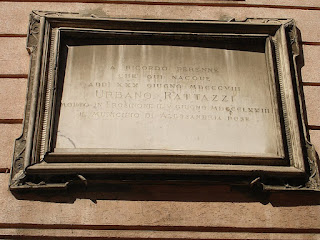Pierre Cardin - fashion designer
Star of Parisian haute couture was born in Italy
Pierre Cardin, who has been described as the last survivor of the heyday of Parisian haute couture in the 50s and 60s, was born on this day in 1922 in the province of Treviso, north of Venice. There are differing versions of the story of Cardin’s Italian origins. One says that his parents were French but had a holiday home in Italy and that he was born in the village of Sant’ Andrea di Barbarana, on the Piave river, where his parents had a house. Another says that his father was Italian, a labourer, that he was born in another small town in the province, San Biagio di Callalta and that he was the last of 11 children. This version suggests his father was in his 60s when Pierre – christened Pietro – was born. What is agreed is that the family left Italy for France in 1924, possibly because of his father’s unease at the rise of Mussolini and his opposition to Fascism. Read more…
________________________________________
Carlo Pisacane – socialist and revolutionary
Patriot who put deeds before ideas
Carlo Pisacane, Duke of San Giovanni, was killed on this day in 1857 at Sanza in Campania, while trying to provoke an uprising in the Kingdom of Naples. Pisacane is remembered for coming up with the concept ‘propaganda of the deed’, an idea that influenced Mussolini and many rebels and terrorists subsequently. He argued that violence was necessary, not only to draw attention or generate publicity for a cause, but to inform, educate and rally the masses to join in. Pisacane was born into an impoverished but noble family in Naples in 1818. He joined the Neapolitan army at the age of 20, but became interested in the political ideas of Giuseppe Mazzini and went to England and France before going to serve in the French army in Algeria. After the revolution of 1848 he came back to Italy, where he played a part in the brief life of the Roman Republic. Read more…
Palio di Siena
First of two annual races contested on 2 July
The first of the two annual contests for the historic Palio di Siena takes place in Piazza del Campo on 2 July. The passionately competitive horse race, first run in 1656, is staged on this date and 16 August each year. The first race is in honour of Siena's Madonna of Provenzano, the second forms part of the celebrations marking the Feast of the Assumption. A colourful pageant, the Corteo Storico, precedes the race, which sees the square filled with spectators from many parts of the world. The Palio features 10 horses, each representing one of Siena's 17 contrade, or wards, ridden bareback by riders wearing the colours of the contrada they represent. They race for three circuits of a dirt track laid around the perimeter of the Piazza del Campo. It is an event with no holds barred. Riders are allowed to use the whip to encourage their own mounts but also to hamper their rivals and falls are frequent. Read more…
______________________________________
Book of the Day: Pierre Cardin: Making Fashion Modern, by Jean-Pascal Hesse and Pierre Pelegry
Pierre Cardin’s designs were worn by an international elite of beautiful women, from Jackie Kennedy to Lauren Bacall and Jeanne Moreau. A close friend of André Courrèges and Paco Rabanne, Cardin revolutionized modern fashion in the mid-1960s, creating iconic designs that continue to resonate today. His many talents and mastery of materials - from fabrics to plastics - extended from haute couture to ready-to-wear, menswear, jewellery, furniture design, perfumes, and accessories, while his business acumen led him to create an empire that stretched from China to the United States. In Pierre Cardin: Making Fashion Modern, long-time Cardin collaborator Jean- Pascal Hesse shares his intimate knowledge of the designer’s early career in Paris, and analyses the creative influences and partnerships that inspired Cardin to design some of the most emblematic haute couture creations of the 1950s and 1960s.Historian and author Jean-Pascal Hesse has worked closely with Pierre Cardin for many years, including as director of communications for the Pierre Cardin Group. He also works for the mayor of the Sixteenth Arrondissement on important cultural events in Paris.

.jpg)





.jpeg)




.jpg)






_-_Exterior.jpg)